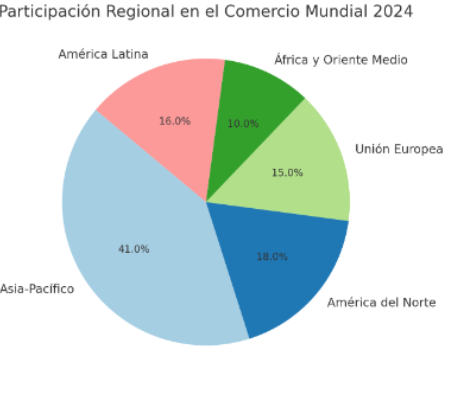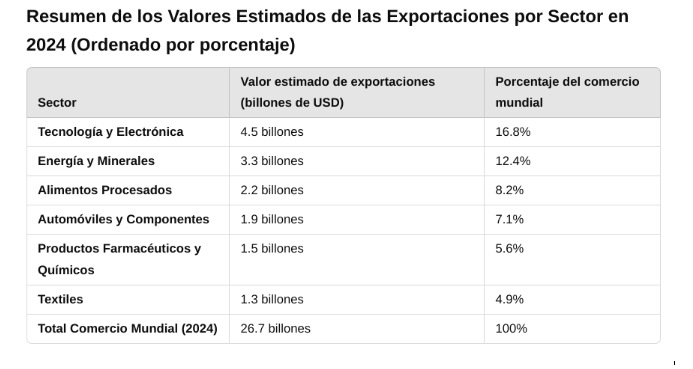
Global trade is facing a transformation marked by regional dynamics and the importance of digitalisation and decarbonisation. In the first part of this article, we present an analysis of key data on world trade in 2024, disaggregated by region and country, and main exporting sectors.
Timed to coincide with the end of the year 2024, this article will look at the key global trade data for 2024, broken down by region and country, and main sectors.
Global Data
World trade has shown a remarkable recovery and growth in 2024, with an increase of 3.7% in the trade of goods and services, reaching a total value of $26.7 billion, according to the World Trade Report 2024 of the World Trade Organization (WTO).
This growth has been driven mainly by demand for technological, sustainable products and processed foods. These sectors, associated with global digitization and decarbonization, have been crucial to XXIst century economic growth.
Regional analysis
By region, world trade in 2024 was distributed as follows
- Asia-Pacific: It has consolidated as the most dynamic trade region and world trade leader, accounting for 41% of the total. Especially China, which led world exports with a growth of 5.2% compared to the previous year. The key exports of this region are both technological products (+9.1%) and textiles (+6.3%). The region’s external trade is undergoing a structural change, with exports of high added value.
- North America: Represented the second largest trading region in the world with 18 % of world trade (although far removed from the Asia-Pacific region). Two countries were the most prominent: the United States and Mexico.The United States experienced a 4.8% growth in its exports, mainly of technological goods and agricultural products. While, for its part, Mexico consolidated as a key manufacturing hub, with growth of 7.5% in exports of automobiles and components.
- Latin America: The region with the greatest trade dynamism (together with the Asia-Pacific region). In fact, it has become the third largest trading region in the world with 16% of the total. Two countries stand out: Brazil and Chile. Brazil led the region’s exports with 6.4% growth, thanks to soy and mineral products. While Chile excelled in lithium exports (+9.3%), driven by the growing demand for batteries for electric vehicles.
- European Union: It ended 2024 as the fourth largest trading region with 15% of total world exports. Attacking mainly Germany and Italy. Germany continued as a regional leader, with exports of industrial machinery and equipment growing (+4.2%), while Italy stood out for its increase in exports of processed foods (+6.1%).
- Africa and the Middle East: Although the region of Africa and the Middle East was the last trading region, it experienced a significant growth during 2024, reaching 10% of global trade. This growth was mainly due to the growth of interregional trade (+5.8%), driven by the African Free Trade Agreement (AFCFTA). The key exports are both energy and agricultural products.

Main export sectors
As regards the export sectors, in 2024 international trade was dominated by six sectors which accounted for 55% of total world exports; and:
- Technology and Electronics: Technology remains the most dynamic sector worldwide and the leading sector, accounting for 16.8% of world trade. With an estimated growth of +9.1% in technology exports, demand for products such as semiconductors, electronic devices and telecommunications equipment has reached record levels. In particular, Asian countries, especially China, have established themselves as the major exporters of these products. On the other hand, the US also stood out in 2024 presenting a significant growth of +4.8% in its exports, especially in semiconductors and advanced technology.
- Energy and Minerals: Energy and mineral products have been key in the exports of regions such as Latin America, Africa and the Middle East; being the second most important sector during 2024, representing 12.4% of world trade. In this regard, it is important to highlight the high growth experienced by critical minerals; for example lithium, which has seen a +9.3% growth in exports, driven by demand for batteries for electric vehicles; Highlighting countries such as Chile in lithium and Brazil in the export of mineral products.
- Processed Food The processed food sector remained a key pillar of international trade, accounting for 8.2% of world trade; and saw growth of +6.1%, especially in emerging markets. Exports of agricultural products and processed foods have been a growth driver for countries such as Mexico, Brazil and Germany.
- Motor vehicles and components;: The export of motor vehicles and their components was the fourth largest sector, accounting for 7.1% of world exports. Being one of the most dynamic areas in Latin America, with Mexico standing out as a key manufacturing hub in international trade.
- Pharmaceuticals and chemicals; a growing sector, driven by the post-pandemic recovery and increased demand for medicines and industrial chemicals. The value of pharmaceutical and chemical exports in 2024 was $1.5 trillion, representing 5.6% of world trade. Highlighting countries such as Switzerland, Germany and the USA, which are the main exporters in this sector.
- Textiles: The textile sector has also shown considerable growth, with an increase of +6.3% in exports; and representing 4.9% of world trade. Growth has been driven by advances in sustainability and demands for eco-friendly textiles; led by China, which remains the world’s leading exporter of textiles with robust growth in this sector.

Conclusion
Global trade is undergoing a profound transformation, marked by digitalization, sustainability and growing global interconnectedness.
World trade in 2024 showed strong growth, led by key regions such as Asia-Pacific and sectors such as technology and sustainability; also highlighting the growth of the Latin American region that even surpassed the EU in global exports.
